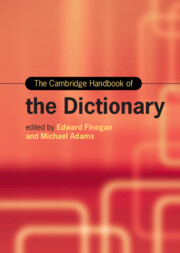Book contents
- The Cambridge Handbook of the Dictionary
- Cambridge Handbooks in Language and Linguistics
- The Cambridge Handbook of the Dictionary
- Copyright page
- Contents
- Figures
- Tables
- Contributors
- Acknowledgments
- Introduction
- Part I Types of Dictionaries
- Chapter 1 Dictionary Typologies
- Chapter 2 Historical and Other Specialized Dictionaries
- Chapter 3 Thesauri
- Chapter 4 Commercial Dictionaries
- Chapter 5 Bilingual Dictionaries
- Chapter 6 Learner’s Dictionaries
- Chapter 7 Children’s Dictionaries
- Chapter 8 Dictionaries of Quotations and Dictionaries of Proverbs
- Part II Dictionaries as Books
- Part III Dictionaries and Ideology
- Part IV Dictionaries and Domains of Use
- Part V The Business of Dictionaries
- Part VI The Future of Dictionaries
- References: Dictionaries
- References: Secondary Works
- Index
Chapter 6 - Learner’s Dictionaries
from Part I - Types of Dictionaries
Published online by Cambridge University Press: 19 October 2024
- The Cambridge Handbook of the Dictionary
- Cambridge Handbooks in Language and Linguistics
- The Cambridge Handbook of the Dictionary
- Copyright page
- Contents
- Figures
- Tables
- Contributors
- Acknowledgments
- Introduction
- Part I Types of Dictionaries
- Chapter 1 Dictionary Typologies
- Chapter 2 Historical and Other Specialized Dictionaries
- Chapter 3 Thesauri
- Chapter 4 Commercial Dictionaries
- Chapter 5 Bilingual Dictionaries
- Chapter 6 Learner’s Dictionaries
- Chapter 7 Children’s Dictionaries
- Chapter 8 Dictionaries of Quotations and Dictionaries of Proverbs
- Part II Dictionaries as Books
- Part III Dictionaries and Ideology
- Part IV Dictionaries and Domains of Use
- Part V The Business of Dictionaries
- Part VI The Future of Dictionaries
- References: Dictionaries
- References: Secondary Works
- Index
Summary
Genesis and development of EFL learner’s dictionaries, innovative methods and features, and influence on dictionaries in other genres. Pioneering examples (NMED, GEW, ISED) featured simple definition, un/countability, verb patterns, collocations, ample examples, pictorial illustrations, IPA, etc., and paved the path for learner’s dictionaries to come; later generations of learner’s dictionaries converged into corpus basis and towards user-friendliness. Innovative and distinctive features include grading of headword importance, transparent grammar indication, signposts/menus for polysemous entries, controlled defining vocabulary, full-sentence definitions, and extensive use of corpora (manifest in frequency-based sense ordering, identification of frequent grammatical and lexical collocations, authentic illustrative examples). Features of English learner’s dictionaries are now incorporated in dictionaries for native speakers, and English learner’s dictionaries and English–Japanese dictionaries have been mutually influential. The evolution and innovation of learner’s dictionaries are mainly motivated by EFL learners’ needs for comprehension and production, driven by users’ rudimentary reference skills, and influenced by digital technology.
- Type
- Chapter
- Information
- The Cambridge Handbook of the Dictionary , pp. 109 - 130Publisher: Cambridge University PressPrint publication year: 2024

